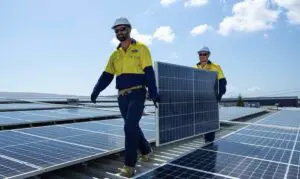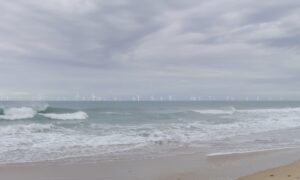One of Australia’s most senior energy executives has let fly at a proposed “priority access” regime put forward by the industry’s rule makers, saying it will leave new wind and solar projects stranded on the grid, and raise costs for consumers.
Paul Simshauser, the CEO of the Queensland government owned PowerLink, which operates the state’s main transmission lines, described the proposed regime as “crazy” and said that, while it might have made sense in a world with coal and gas, it made no sense for a grid dominated by renewable energy.
“I’ve crunched the numbers on this stuff ad nauseam,” said Professor Simshauser, also a highly respected author of academic research on the energy industry.
“If you go down a priority access regime, and it’s perfect in the old world when you had coal and gas, I get it …. when you go into a renewables world, priority access means you will constraint immeasurable amounts of good projects because the first project gets completely unconstrained.
“We should all accept a certain level of curtailment, but (under this proposed regime) consumers will be worse off.”
Simshauser says it applies to projects inside and outside renewable energy zones, and says there will up to 30 per cent less output from the wind and solar projects that might otherwise have been the case, and added costs to make up the difference.
The broadside from Simshauser is just the latest development in the problematic question around grid access. There have been numerous proposals coming from the board of the Energy Security Board, such as the ill-fated Cogati, intense debate about locational marginal pricing, and which projects could or should get priority, and what would work best.
The grid access problem has led to the creation of renewable energy zones in multiple states, and in NSW project developers are being given the opportunity to buy “access rights” that should in theory limit the amount of curtailment.
The AEMC rolled out its latest proposal last month, which is based on its own now controversial version of a “priority access” regime, and submissions are due at the end of this week. But it is already clear that state governments are going their own way on this matter.
Victoria, for instance, announced earlier this week it was going its own way, drawing up its own grid access rules under charges to be managed by the newly formed VicGrid.
Queensland, meanwhile, is attempting to transition from renewable laggard with the biggest dependency on coal, to sector leader, and is doing this mainly through the benefits of state ownership of the coal fleet, and the transmission and distribution operators.
The debate about access regimes has gone hand in hand with questions about the wisdom of new renewable energy zones, and whether this will actually smooth the problems or exacerbate them, particular amid cost blowouts and delays to many proposed REZs.
Victoria’s move on Tuesday prompted debate on LinkedIn, for instance.
“I’ve spoken to many and seen no indication that investors are moving their return hurdle down in this already highly competitive space,” wrote Steve Jackson from developer BEA Renewables. “Meanwhile, we have the cost of this consumer funded infrastructure blowing out to extraordinary levels.
“I’d happily bet London to a brick that the cost blowouts alone are a material multiple of any ‘financing benefit’ of providing curtailment limits to a handful of generators let alone the consumer cost benefits that might come from more generation utilising very costly consumer funded infrastructure.
“Love it or hate it, open access to our grid drives utilisation efficiency of our grid – which is a huge part of the cost consumers pay and changing that in parts of our consumer funded grid is an experiment that I suspect reverses when consumers realise what it’s costing them.”
Simshauser says that Queensland’s approach to renewable energy zones has been deliberately different to other states, and has looked at smaller zones that can be quicker to deliver. The state now has the highest number of new projects under construction of any state.
Simshauser has recently co-authored a paper on priority access regimes with Professor David Newbery, a UK based energy and economics expert from the University of Cambridge.
The paper concludes that there will be significant added costs to consumers to reach the same level of wind and solar output if the regime was to go ahead.
He notes that a non-firm access regime would allow Queensland to deliver its targeted 80 per cent share of renewables with five renewable energy zones.
“Under priority access, seven fully subscribed renewable energy zones would be required to deliver the same result,” his paper says.
“That means … to more episodes of navigating the complexity of encroaching on private land,. risks of disturbing sites of cultural significant and other environmental objecting, and above all, enduring backlash from two more affected communities.
“Good luck with that,” he noted at the conference.
The paper says the priority access regime would require the long run marginal costs of solar, for instance, to jump from $65/MWh to $91/MWh, which would translate into an additional burden of around $169 million for every 1,500MW of capacity in a REZ.
For wind, the cost of 2,300 MW of capacity would jump from around $72/MWh to more than $97/MWh.
“The key issue is that priority access means less renewables are bankable, and those that are will be bulletproof,” Simshauser says. “Whereas our open access, perhaps with aggregate megawatt caps, that shares the pain so more megawatts are built.”








